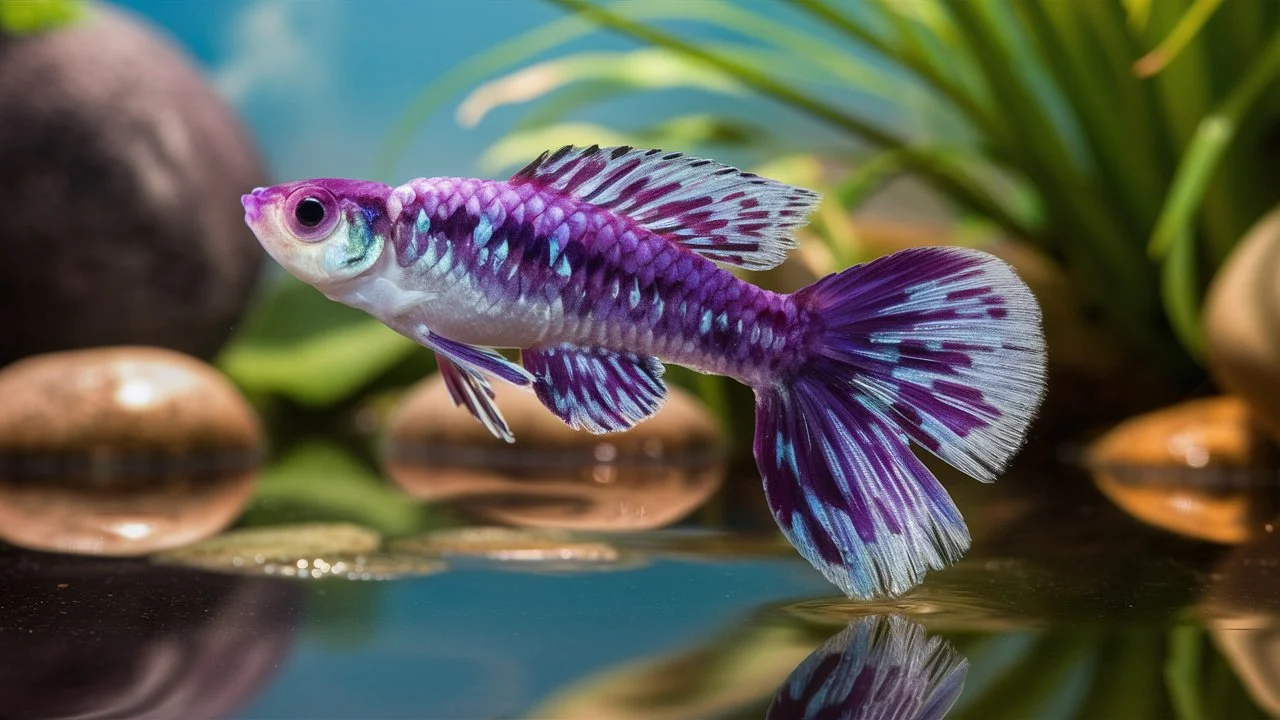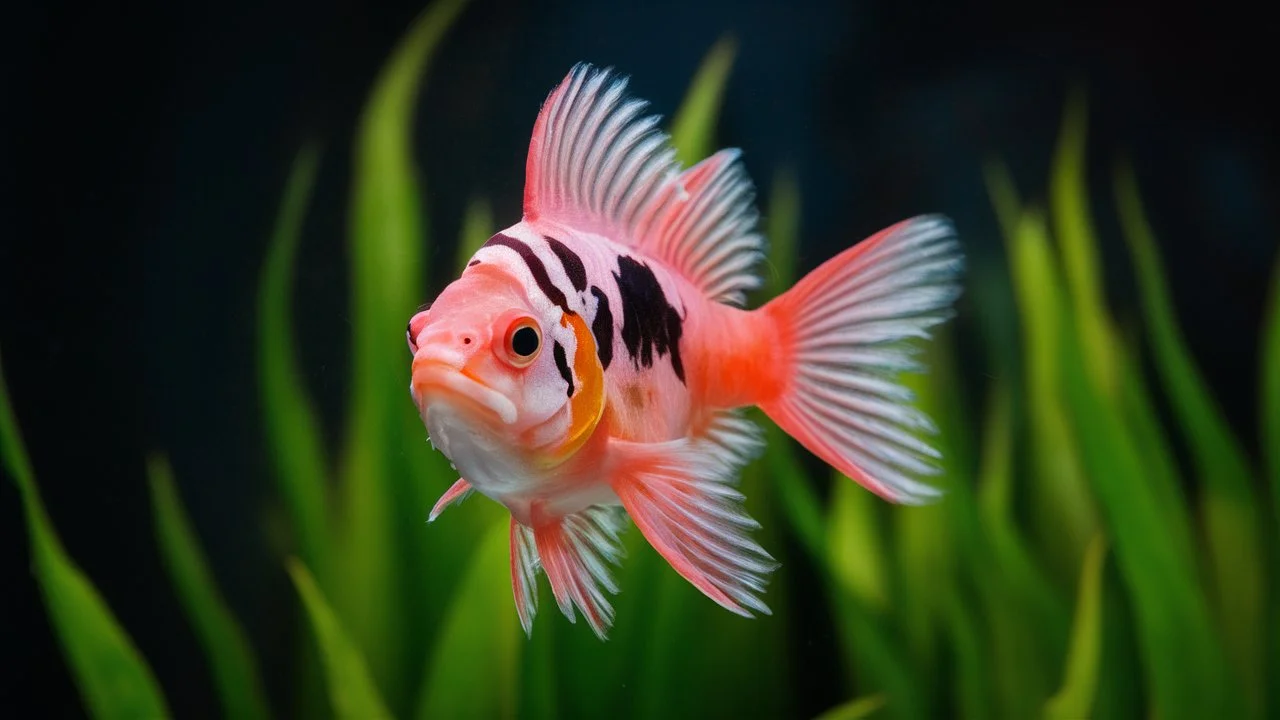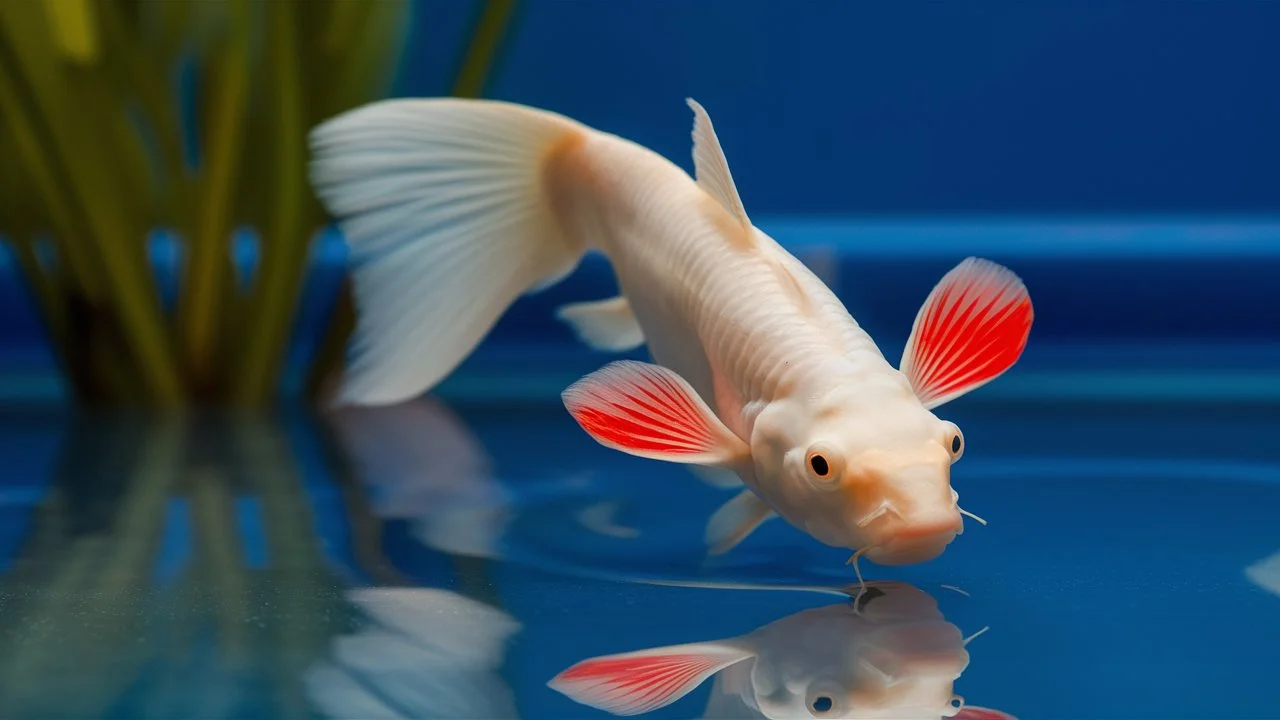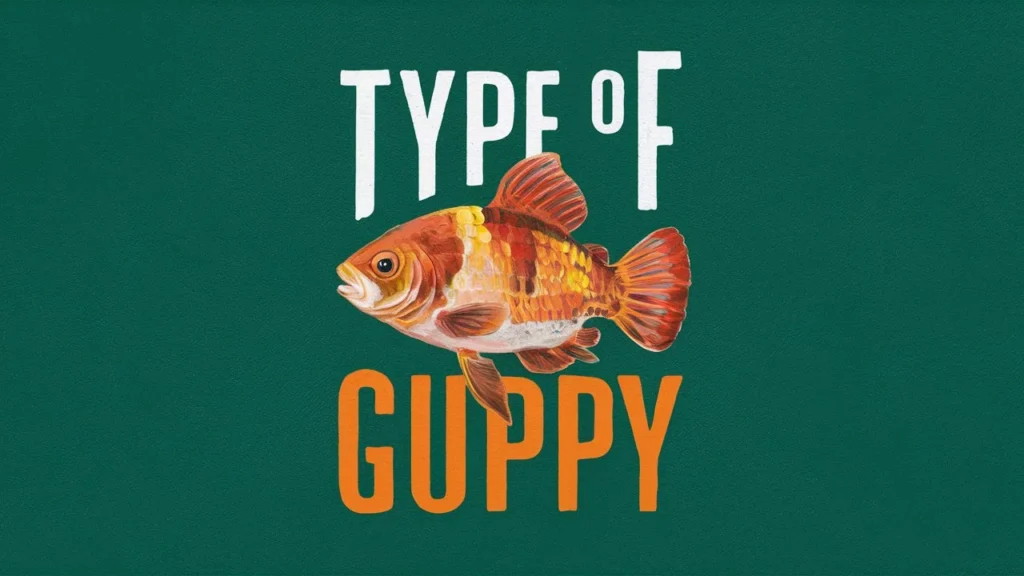Introduction to Guppy Fish
They were named after Robert John Lechmere Guppy, the person who first found them.
People love guppy fish because they are easy to care for and have bright, eye catching colors.
They are very active swimmers and fun to watch in any home aquarium.
Guppies are livebearers, which means they give birth to live baby guppies instead of laying eggs.
| Guppy Type | Tail Shape | Colors | Special Features |
|---|---|---|---|
| Delta Tail Guppy | Wide, triangle-shaped | Any color, often multi-colored | Large, eye-catching tail compared to their bodies |
| Moscow Guppy | Long, flowing tail | Blue, green, red, black (metallic shine) | Vibrant, metallic colors |
| Endler’s Guppy | Short, less dramatic tail | Bright, neon-like colors | Small size, very active swimmers |
| Common Wild Guppy | Small, rounded tail | Grey with tiny spots | Hardy, beginner-friendly, easy to care for |
| Tuxedo Guppy | Rounded or fan-shaped | Two-toned: dark back, light front | Unique “tuxedo” color pattern |
| Snakeskin Guppy | Long, flowing tail | Snake-like spots and stripes | Spotted and striped patterns like a snake’s skin |
| Albino Guppy | Various tail shapes | White or light pink, red eyes | No pigment, soft ghost-like appearance |
| Lyretail Guppy | Long tail split into two points | Any color, often bright and shiny | Elegant, lyre-shaped tail |
Basic Care for Guppy Fish
Before we jump into the different types of guppies, it’s important to know how to take care of them the right way. Guppies need a proper home, and while a 5 to 10 gallon tank is okay, a larger 20 to gallon aquarium gives them more space to swim and stay stress free. Keep the water warm between 74 to 82°F (23 to 28°C) using a heater so the temperature stays steady. Clean water is a must for healthy guppies, so make sure to use a filter and change around 25% of the water every week to remove dirt and harmful chemicals. When it comes to food, feed your guppy fish 2 to 3 small meals a day with a mix of fish flakes, brine shrimp, and daphnia to keep them strong and colorful. Guppies are peaceful fish, so they get along well with friendly tank mates like tetras, mollies, and platies, making your aquarium calm and full of life.
Types of Guppy Fish
Now, let’s take a closer look at the different types of guppy fish, including their tail shapes, colors, and unique features.
Fancy Guppies
Fancy guppies are loved for their bright colors, eye catching patterns, and beautiful tail shapes. These stunning aquarium fish come in many different sizes and styles, which makes each one unique and fun to watch. In this guide, we’ll explore some of the most common types of fancy guppies so you can easily recognize and appreciate their beauty.

1. Delta Tail Guppy
Delta tail guppies are loved for their wide, triangle shaped tails that look just like the Greek letter delta (Δ). Their large, flowing tails move gracefully in the water, making them appear elegant and charming, almost like tiny underwater kites. These guppies can come in almost any color: red, blue, green, yellow, or even a mix of several shades. Many also have unique patterns such as spots, stripes, or metallic shine, which make them even more eye catching. What makes delta tail guppies truly special is how big their tails are compared to their small bodies, giving them a stunning and regal look. Because of their beauty, bright colors, and smooth swimming style, delta tail guppies are a top choice for aquarium lovers and beginner fish keepers.
2. Moscow Guppy
Tail Shape: Moscow guppies have different tail shapes. Their tails are often large, flowing, and eye catching, making them a favorite in many home aquariums.
Colors: These guppies usually come in bright blue or green shades, but they can also be found in red or black. Their colors are bold and shimmer beautifully under aquarium lights.
Special Feature: Moscow guppies are most famous for their vibrant, metallic colors. This shiny, reflective look makes them stand out from other guppy breeds and adds a touch of elegance to any fish tank.
Moscow guppies are named after the city of Moscow in Russia. They are loved by fish lovers for their bright, metallic colors that sparkle when light hits them. These aquarium fish can have different tail types like delta shaped tails, fan shaped tails, or sword shaped tails. The most common colors you’ll see are blue Moscow guppies and green Moscow guppies, but some also come in red and black. Their shiny, metallic body makes them a popular choice for beginner fish keepers, guppy breeders, and aquarium hobbyists.
3. Endler’s Guppy
Tail Shape: Endler’s guppies have smaller tails than most fancy guppies, but their tails are still colorful and playful looking.
Colors: These tiny fish show off bright, neon like colors. You can spot shades of green, orange, and yellow, often mixed with spots, bars, or other cool patterns.
Special Feature: Endler’s guppies are known for being small, fast, and super active. Their constant movement makes them fun and exciting to watch in any home aquarium.
Endler’s guppies are a special type of guppy fish. They are smaller than regular guppies and love to swim around quickly. Their bright neon colors, like green, orange, and yellow, make them look like swimming rainbows. Many of them have unique patterns such as tiny spots or stripes. Because of their small size, playful nature, and non stop energy, Endler’s livebearers are a favorite for beginner fish keepers, nano tanks, and community aquariums.
Hybrid Guppies
Hybrid guppies are created by mixing different types of guppies. Breeders carefully pair them to bring out the best traits from each parent, such as brighter colors, unique tail shapes, or stronger health.

5. Tuxedo Guppy
Tail Shape: Tuxedo guppies come in different tail shapes, most often rounded or slightly fan shaped, adding to their gentle and graceful look.
Colors: These guppy fish usually have two toned colors, dark shades like black or blue on the back half, and lighter colors like white or yellow on the front.
Special Feature: They are called tuxedo guppies because their color pattern looks like a tiny tuxedo, giving them a classy and elegant appearance.
Tuxedo guppies get their name from their tuxedo style colors. The back part of their body is usually dark, while the front part is lighter, creating a bold and stylish contrast. This makes them stand out in any aquarium. While they can have different tail shapes, it’s their sharp color division that makes tuxedo guppies so unique and popular among guppy lovers and aquarium hobbyists.
6. Snakeskin Guppy
Tail Shape: Snakeskin guppies have long, flowing tails that move gracefully through the water, giving them a stunning and elegant look.
Colors: Their bodies are covered in patterns that look like a snake’s skin, with tiny spots, wavy lines, or stripes in shades of red, orange, blue, or green.
Special Feature: This snakeskin pattern makes them stand out instantly in any aquarium and adds a touch of mystery and beauty.
Snakeskin guppies are easy to recognize thanks to their detailed, scale like patterns. Their bodies and tails are decorated with spotted and striped designs that resemble a real snake’s skin. These colorful guppy fish often come in bright shades like red, orange, blue, and green. Along with their long, flowing tails, their exotic look makes them a favorite choice for fish keepers who love eye catching and unique aquarium fish.
Special Guppies
Some guppies have unique traits and special features that make them stand out from other guppy fish.

7. Albino Guppy
Tail Shape: Albino guppies can have all kinds of tail shapes, from fan tails to delta tails, just like other guppy fish.
Colors: They are usually white or very light pink, and their bright red eyes make them stand out.
Special Feature: Albino guppies don’t have pigment, which gives them a soft, ghost like appearance that looks magical in the water.
Albino guppies are special because they don’t have the pigments that give most guppies their bright colors. Instead, their bodies are pale white or light pink, and their red eyes are a clear sign of this genetic trait. Even though they can have any tail shape, their light color and glowing red eyes make them easy to recognize. These gentle and delicate aquarium fish need clean water and good care to stay healthy and happy.
8. Lyretail Guppy
Tail Shape: Lyretail guppies have long, flowing tails that split into two thin points, just like the shape of a lyre, a stringed musical instrument.
Colors: They can be found in many colors, often bright and vibrant, making them stand out in any aquarium.
Special Feature: Their lyre shaped tail is elegant, graceful, and instantly catches your attention.
Lyretail guppies are one of the most easily recognized guppy fish because of their unique tail shape. Their tails are long and divided into two tips, giving them a classy and royal appearance. These colorful aquarium fish come in many shades, and their tails glide beautifully as they swim. Because of their striking look and peaceful nature, lyretail guppies are a favorite among fish keepers and guppy lovers.
Wild Guppies
Wild guppies are the types you find living in nature. They might not be as bright or fancy as aquarium guppies, but they still have a simple, natural beauty.
4. Common Wild Guppy
Tail Shape: Wild guppies usually have small, rounded tails instead of large, fancy ones.
Colors: Their bodies are mostly grey or brown, with tiny spots of color on their fins or sides.
Special Feature: Wild guppies are strong, hardy fish and very easy to care for.
Common wild guppies are the original ancestors of all fancy guppy fish kept in aquariums today. They live in freshwater rivers and streams in South America. Unlike colorful fancy guppies, wild guppies have smaller tails and more natural colors like grey, brown, and light spots. Even though they look simple, they are tough, can survive in many water conditions, and are perfect for beginners and outdoor ponds.
Care Tips for Guppies
Taking care of guppies is simple and fun if you follow a few easy steps:
1. Choose the Right Tank:
Start with a 10 gallon fish tank or bigger. More space helps guppies swim freely and stay happy. Always use a tank lid because guppies can jump out of the water.
2. Keep the Water Clean:
Use a fish tank filter to remove dirt and waste. Change about 25% of the water every week to keep it fresh. Test the water often and make sure the pH level stays between 7.0 and 7.8.
3. Control the Temperature:
Guppies are tropical fish, so they need warm water. Keep the temperature between 74 to 82°F (23 to 28°C) using a tank heater. A steady temperature keeps them healthy and active.
4. Feed Them Properly:
Give your guppy fish a balanced diet. High quality fish flakes are great as a daily food. For extra protein, you can add live or frozen food like brine shrimp or daphnia. Feed small amounts 2 to 3 times a day so they don’t overeat.
5. Add Hiding Spots:
Guppies feel safer when they have places to hide. Use aquarium plants, rocks, or decorations to create shelter. This helps reduce stress and keeps them calm.
6. Avoid Overcrowding:
Don’t pack too many fish in one tank. A good rule is 1 gallon of water per inch of fish. Too many guppies can cause dirty water and stress.
7. Watch for Diseases:
Keep an eye on your fish. Look for signs like white spots, clamped fins, or strange behavior. If a guppy looks sick, move it to another tank and use the right medicine to treat it.
Breeding Guppies
How to Breed Guppies the Easy Way (Beginner Friendly Guide)
Breeding guppies is super easy and fun, especially because they’re livebearers, which means they give birth to live baby fish instead of laying eggs. If you’re just getting started with fish breeding, guppies are one of the best and most rewarding choices.
1. Set Up a Breeding Tank
Start by using a separate breeding tank to keep the parents and babies safe. A 10 gallon aquarium is perfect.
Add lots of live or artificial plants, like Java moss or floating plants, so the tiny guppy fry (baby guppies) have safe hiding spots.
2. Pick Strong and Healthy Guppies
Always choose healthy, colorful guppy fish as parents.
- Male guppies are smaller but brighter with fancy tails.
- Female guppies are bigger and usually less colorful.
Good parents mean strong, healthy babies.
3. Introduce the Male and Female
Put one male and one female guppy together in the breeding tank. The male will try to impress the female by showing off his shiny colors and moving his fins in a playful way. This is called guppy mating behavior.
4. Look for Signs of Pregnancy
If the female accepts the male, she will get pregnant. You’ll notice:
- A dark, gravid spot near her back fin.
- Her belly will slowly get rounder as the guppy fry develop inside her.
5. Get Ready for Birth
After about 4 weeks (28 days), the female will give birth to 20 to 100 live guppy fry. That’s a lot of babies! Right after she gives birth, gently move her out of the tank. Sometimes adult guppies might eat their own fry, so it’s safer to separate them.
6. Take Care of the Fry
Now it’s time to care for the tiny babies:
- Feed them crushed fish flakes or special fry food 3 to 4 times a day.
- Keep the water clean and warm to help them grow faster.
- In 2 to 4 weeks, they’ll be big enough to move to the main tank.
Why Breeding Guppies Is So Popular
Breeding guppies is loved by beginners and experts because it’s simple, exciting, and you get to watch new life unfold right in your aquarium. With the right setup and care, you’ll have a tank full of healthy, colorful fish in no time.
FAQs
What are the most popular types of guppy fish?
Some of the most popular guppy types include Moscow Guppies, Tuxedo Guppies, Fancy Guppies, Delta Tail Guppies, Cobra Guppies, and Endler Guppies. Each type is known for its unique color patterns, tail shapes, and fin designs.
How can I tell different guppy fish types apart?
You can identify guppy types by observing their tail shape (like delta, fan, or lyre tail), body color, fin size, and pattern. For example, Cobra Guppies have snake to like patterns, while Moscow Guppies feature a single solid color.
Do different guppy types have different care requirements?
Most guppy types have similar care requirements, such as clean water, a stable temperature of 72 to 82°F (22 to 28°C), and a balanced diet. However, some rarer or show quality guppies may require better water quality and a more controlled environment to maintain their color and health.
Can different types of guppies breed together?
Yes, different guppy types can interbreed easily, which often results in new color variations and tail shapes. However, this also means that keeping multiple types in the same tank may cause mixed offspring instead of pure strains.
Which guppy fish type is best for beginners?
Fancy Guppies and Endler Guppies are great choices for beginners because they are hardy, easy to care for, and widely available. They adapt well to community tanks and can thrive with basic maintenance and care.
Conclusion
Guppies are amazing little fish that come in many colors, patterns, and tail shapes.
Whether you pick a fancy guppy with a bright, flowing tail or a simple wild guppy, they bring life and beauty to any aquarium.
Just make sure to take proper care of your guppies so they can stay happy and healthy in their new home.
With clean water, good food, and the right tank setup, these colorful fish will thrive and swim joyfully for many years.
